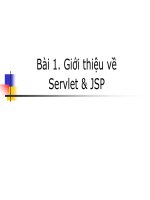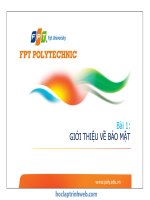Bài giới thiệu về chip ADC8052 - ROM Structure
Bạn đang xem bản rút gọn của tài liệu. Xem và tải ngay bản đầy đủ của tài liệu tại đây (546.08 KB, 24 trang )
Rev.D - 16 November, 2000 33
TS80C32X2
TS87C52X2
TS80C52X2
7. TS80C52X2
7.1 ROM Structure
The TS80C52X2 ROM memory is divided in three different arrays:
●
the code array: . . . . . . . . . . . . . . . . . . . . . . . . . . . . . . . . . . . . . . . . . . . . . . .8 Kbytes.
●
the encryption array: . . . . . . . . . . . . . . . . . . . . . . . . . . . . . . . . . . . . . . . . . . . . 64 bytes.
●
the signature array:. . . . . . . . . . . . . . . . . . . . . . . . . . . . . . . . . . . . . . . . . . . . . .4 bytes.
7.2 ROM Lock System
The program Lock system, when programmed, protects the on-chip program against software piracy.
7.2.1 Encryption Array
Within the ROM array are 64 bytes of encryption array that are initially unprogrammed (all FF’s). Every time a
byte is addressed during program verify, 6 address lines are used to select a byte of the encryption array. This
byte is then exclusive-NOR’ed (XNOR) with the code byte, creating an encrypted verify byte. The algorithm, with
the encryption array in the unprogrammed state, will return the code in its original, unmodified form.
When using the encryption array, one important factor needs to be considered. If a byte has the value FFh, verifying
the byte will produce the encryption byte value. If a large block (>64 bytes) of code is left unprogrammed, a
verification routine will display the content of the encryption array. For this reason all the unused code bytes
should be programmed with random values. This will ensure program protection.
7.2.2 Program Lock Bits
The lock bits when programmed according to Table 18. will provide different level of protection for the on-chip
code and data.
U: unprogrammed
P: programmed
7.2.3 Signature bytes
The TS80C52X2 contains 4 factory programmed signatures bytes. To read these bytes, perform the process described
in section 9.
7.2.4 Verify Algorithm
Refer to 8.3.4
Table 18. Program Lock bits
Program Lock Bits
Protection description
Security
level
LB1 LB2 LB3
1 U U U
No program lock features enabled. Code verify will still be encrypted by the encryption
array if programmed. MOVC instruction executedfrom external program memory returns
non encrypted data.
2 P U U
MOVC instruction executed from external program memory are disabled from fetching
code bytes from internal memory, EA is sampled and latched on reset.
34 Rev.D - 16 November, 2000
TS80C32X2
TS87C52X2
TS80C52X2
8. TS87C52X2
8.1 EPROM Structure
The TS87C52X2 is divided in two different arrays:
●
the code array: . . . . . . . . . . . . . . . . . . . . . . . . . . . . . . . . . . . . . . . . . . . . . . 8 Kbytes.
●
the encryption array: . . . . . . . . . . . . . . . . . . . . . . . . . . . . . . . . . . . . . . . . . . . . 64 bytes.
In addition a third non programmable array is implemented:
●
the signature array: . . . . . . . . . . . . . . . . . . . . . . . . . . . . . . . . . . . . . . . . . . . . 4 bytes.
8.2 EPROM Lock System
The program Lock system, when programmed, protects the on-chip program against software piracy.
8.2.1 Encryption Array
Within the EPROM array are 64 bytes of encryption array that are initially unprogrammed (all FF’s). Every time
a byte is addressed during program verify, 6 address lines are used to select a byte of the encryption array. This
byte is then exclusive-NOR’ed (XNOR) with the code byte, creating an encrypted verify byte. The algorithm, with
the encryption array in the unprogrammed state, will return the code in its original, unmodified form.
When using the encryption array, one important factor needs to be considered. If a byte has the value FFh, verifying
the byte will produce the encryption byte value. If a large block (>64 bytes) of code is left unprogrammed, a
verification routine will display the content of the encryption array. For this reason all the unused code bytes
should be programmed with random values. This will ensure program protection.
8.2.2 Program Lock Bits
The three lock bits, when programmed according to Table 19., will provide different level of protection for the
on-chip code and data.
U: unprogrammed,
P: programmed
WARNING: Security level 2 and 3 should only be programmed after EPROM and Core verification.
Table 19. Program Lock bits
Program Lock Bits
Protection description
Security
level
LB1 LB2 LB3
1 U U U
No program lock features enabled. Code verify will still be encrypted by the encryption
array if programmed. MOVC instruction executed from external program memory
returns non encrypted data.
2 P U U
MOVC instruction executedfromexternalprogram memory are disabled from fetching
code bytes from internal memory, EA is sampled and latched on reset, and further
programming of the EPROM is disabled.
3 U P U Same as 2, also verify is disabled.
4 U U P Same as 3, also external execution is disabled.
Rev.D - 16 November, 2000 35
TS80C32X2
TS87C52X2
TS80C52X2
8.2.3 Signature bytes
The TS80/87C52X2 contains 4 factory programmed signatures bytes. To read these bytes, perform the process
described in section 9.
8.3 EPROM Programming
8.3.1 Set-up modes
In order to program and verify the EPROM or to read the signature bytes, the TS87C52X2 is placed in specific
set-up modes (See Figure 11.).
Control and program signals must be held at the levels indicated in Table 35.
8.3.2 Definition of terms
Address Lines:P1.0-P1.7, P2.0-P2.4 respectively for A0-A12
Data Lines:P0.0-P0.7 for D0-D7
Control Signals:RST, PSEN, P2.6, P2.7, P3.3, P3.6, P3.7.
Program Signals:ALE/PROG, EA/VPP.
Table 20. EPROM Set-Up Modes
Mode RST PSEN
ALE/
PROG
EA/
VPP
P2.6 P2.7 P3.3 P3.6 P3.7
Program Code data 1 0 12.75V 0 1 1 1 1
Verify Code data 1 0 1 1 0 0 1 1
Program Encryption Array
Address 0-3Fh
1 0 12.75V 0 1 1 0 1
Read Signature Bytes 1 0 1 1 0 0 0 0
Program Lock bit 1 1 0 12.75V 1 1 1 1 1
Program Lock bit 2 1 0 12.75V 1 1 1 0 0
Program Lock bit 3 1 0 12.75V 1 0 1 1 0
36 Rev.D - 16 November, 2000
TS80C32X2
TS87C52X2
TS80C52X2
Figure 11. Set-Up Modes Configuration
8.3.3 Programming Algorithm
The Improved Quick Pulse algorithm is based on the Quick Pulse algorithm and decreases the number of pulses
applied during byte programming from 25 to 1.
To program the TS87C52X2 the following sequence must be exercised:
●
Step 1: Activate the combination of control signals.
●
Step 2: Input the valid address on the address lines.
●
Step 3: Input the appropriate data on the data lines.
●
Step 4: Raise EA/VPP from VCC to VPP (typical 12.75V).
●
Step 5: Pulse ALE/PROG once.
●
Step 6: Lower EA/VPP from VPP to VCC
Repeat step 2 through 6 changing the address and data for the entire array or until the end of the object file is
reached (See Figure 12.).
8.3.4 Verify algorithm
Code array verify must be done after each byte or block of bytes is programmed. In either case, a complete verify
of the programmed array will ensure reliable programming of the TS87C52X2.
P 2.7 is used to enable data output.
To verify the TS87C52X2 code the following sequence must be exercised:
●
Step 1: Activate the combination of program and control signals.
●
Step 2: Input the valid address on the address lines.
●
Step 3: Read data on the data lines.
Repeat step 2 through 3 changing the address for the entire array verification (See Figure 12.)
The encryption array cannot be directly verified. Verification of the encryption array is done by observing that the
code array is well encrypted.
+5V
VCC
P0.0-P0.7
P1.0-P1.7
P2.0-P2.4
VSS
GND
D0-D7
A0-A7
A8-A12
RST
EA/VPP
ALE/PROG
PSEN
P2.6
P2.7
P3.3
P3.7
P3.6
XTAL14 to 6 MHz
CONTROL
SIGNALS*
PROGRAM
SIGNALS*
* See Table 31. for proper value on these inputs
Rev.D - 16 November, 2000 37
TS80C32X2
TS87C52X2
TS80C52X2
Figure 12. Programming and Verification Signal’s Waveform
8.4 EPROM Erasure (Windowed Packages Only)
Erasing the EPROM erases the code array, the encryption array and the lock bits returning the parts to full
functionality.
Erasure leaves all the EPROM cells in a 1’s state (FF).
8.4.1 Erasure Characteristics
The recommended erasure procedure is exposure to ultraviolet light (at 2537 Å) to an integrated dose at least 15
W-sec/cm
2
. Exposing the EPROM to an ultraviolet lamp of 12,000 µW/cm
2
rating for 30 minutes, at a distance
of about 25 mm, should be sufficient. An exposure of 1 hour is recommended with most of standard erasers.
Erasure of the EPROM begins to occur when the chip is exposed to light with wavelength shorter than approximately
4,000 Å. Since sunlight and fluorescent lighting have wavelengths in this range, exposure to these light sources
over an extended time (about 1 week in sunlight, or 3 years in room-level fluorescent lighting) could cause
inadvertent erasure. If an application subjects the device to this type of exposure, it is suggested that an opaque
label be placed over the window.
Control signals
Data In
ALE/
PROG
A0-A12
Programming Cycle
100µs
D0-D7
EA/VPP
Data Out
Read/Verify Cycle
12.75V
5V
0V
38 Rev.D - 16 November, 2000
TS80C32X2
TS87C52X2
TS80C52X2
9. Signature Bytes
The TS80/87C52X2 has four signature bytes in location 30h, 31h, 60h and 61h. To read these bytes follow the
procedure for EPROM verify but activate the control lines provided in Table 31. for Read Signature Bytes. Table
35. shows the content of the signature byte for the TS80/87C52X2.
Table 21. Signature Bytes Content
Location Contents Comment
30h 58h Manufacturer Code: Atmel Wireless & Microcontrollers
31h 57h Family Code: C51 X2
60h 2Dh Product name: TS80C52X2
60h ADh Product name: TS87C52X2
60h 20h Product name: TS80C32X2
61h FFh Product revision number
Rev.D - 16 November, 2000 39
TS80C32X2
TS87C52X2
TS80C52X2
10. Electrical Characteristics
10.1 Absolute Maximum Ratings
(1)
Ambiant Temperature Under Bias:
C = commercial 0°Cto70°C
I = industrial -40°Cto85°C
Storage Temperature -65°Cto+150°C
Voltage on V
CC
to V
SS
-0.5Vto+7V
Voltage on V
PP
to V
SS
-0.5Vto+13V
Voltage on Any Pin to V
SS
-0.5VtoV
CC
+ 0.5 V
Power Dissipation 1 W
(2)
NOTES
1.
S
tresses at or above those listed under “ Absolute Maximum Ratings” may cause permanent damage to the device. This is a stress rating only
and functional operation of the device at these or any other conditions above those indicated in the operational sections of this specification is not
implied. Exposure to absolute maximum rating conditions may affect device reliability.
2. This value is based on the maximum allowable die temperature and the thermal resistance of the package.
10.2 Power consumption measurement
Since the introduction of the first C51 devices, every manufacturer made operating Icc measurements under reset,
which made sense for the designs were the CPU was running under reset. In Atmel Wireless & Microcontrollers
new devices, the CPU is no more active during reset, so the power consumption is very low but is not really
representative of what will happen in the customer system. That’s why, while keeping measurements under Reset,
Atmel Wireless & Microcontrollers presents a new way to measure the operating Icc:
Using an internal test ROM, the following code is executed:
Label: SJMP Label (80 FE)
Ports 1, 2, 3 are disconnected, Port 0 is tied to FFh, EA = Vcc, RST = Vss, XTAL2 is not connected and XTAL1
is driven by the clock.
This is much more representative of the real operating Icc.
40 Rev.D - 16 November, 2000
TS80C32X2
TS87C52X2
TS80C52X2
10.3 DC Parameters for Standard Voltage
T
A
=0°Cto+70°C; V
SS
=0V;V
CC
=5V± 10%;F=0to40MHz.
T
A
= -40°Cto+85°C; V
SS
=0V;V
CC
=5V± 10%;F=0to40MHz.
Table 22. DC Parameters in Standard Voltage
Symbol Parameter Min Typ Max Unit Test Conditions
V
IL
Input Low Voltage -0.5 0.2 V
CC
- 0.1 V
V
IH
Input High Voltage except XTAL1, RST 0.2 V
CC
+ 0.9 V
CC
+ 0.5 V
V
IH1
Input High Voltage, XTAL1, RST 0.7 V
CC
V
CC
+ 0.5 V
V
OL
Output Low Voltage, ports 1, 2, 3
(6)
0.3
0.45
1.0
V
V
V
I
OL
= 100 µA
(4)
I
OL
= 1.6 mA
(4)
I
OL
= 3.5 mA
(4)
V
OL1
Output Low Voltage, port 0
(6)
0.3
0.45
1.0
V
V
V
I
OL
= 200 µA
(4)
I
OL
= 3.2 mA
(4)
I
OL
= 7.0 mA
(4)
V
OL2
Output Low Voltage, ALE, PSEN 0.3
0.45
1.0
V
V
V
I
OL
= 100 µA
(4)
I
OL
= 1.6 mA
(4)
I
OL
= 3.5 mA
(4)
V
OH
Output High Voltage, ports 1, 2, 3 V
CC
- 0.3
V
CC
- 0.7
V
CC
- 1.5
V
V
V
I
OH
= -10 µA
I
OH
= -30 µA
I
OH
= -60 µA
V
CC
= 5 V ± 10%
V
OH1
Output High Voltage, port 0 V
CC
- 0.3
V
CC
- 0.7
V
CC
- 1.5
V
V
V
I
OH
= -200 µA
I
OH
= -3.2 mA
I
OH
= -7.0 mA
V
CC
= 5 V ± 10%
V
OH2
Output High Voltage,ALE, PSEN V
CC
- 0.3
V
CC
- 0.7
V
CC
- 1.5
V
V
V
I
OH
= -100 µA
I
OH
= -1.6 mA
I
OH
= -3.5 mA
V
CC
= 5 V ± 10%
R
RST
RST Pulldown Resistor 50
90
(5)
200 kΩ
I
IL
Logical 0 Input Current ports 1, 2 and 3 -50 µA Vin = 0.45 V
I
LI
Input Leakage Current ±10 µA 0.45 V < Vin < V
CC
I
TL
Logical 1 to 0 Transition Current, ports 1, 2, 3 -650 µA Vin = 2.0 V
C
IO
Capacitance of I/O Buffer 10 pF Fc = 1 MHz
T
A
= 25°C
I
PD
Power Down Current
20
(5)
50 µA
2.0 V < V
CC <
5.5 V
(3)
I
CC
under
RESET
Power Supply Current Maximum values, X1
mode:
(7)
1 + 0.4 Freq
(MHz)
@12MHz 5.8
@16MHz 7.4
mA
V
CC
= 5.5 V
(1)
Rev.D - 16 November, 2000 41
TS80C32X2
TS87C52X2
TS80C52X2
10.4 DC Parameters for Low Voltage
T
A
=0°Cto+70°C; V
SS
=0V;V
CC
=2.7Vto5.5V;F=0to30MHz.
T
A
= -40°Cto+85°C; V
SS
=0V;V
CC
=2.7Vto5.5V;F=0to30MHz.
Table 23. DC Parameters for Low Voltage
I
CC
operating
Power Supply Current Maximum values, X1
mode:
(7)
3 + 0.6 Freq
(MHz)
@12MHz 10.2
@16MHz 12.6
mA
V
CC
= 5.5 V
(8)
I
CC
idle
Power Supply Current Maximum values, X1
mode:
(7)
0.25+0.3Freq
(MHz)
@12MHz 3.9
@16MHz 5.1
mA
V
CC
= 5.5 V
(2)
Symbol Parameter Min Typ Max Unit Test Conditions
V
IL
Input Low Voltage -0.5 0.2 V
CC
- 0.1 V
V
IH
Input High Voltage except XTAL1, RST 0.2 V
CC
+ 0.9 V
CC
+ 0.5 V
V
IH1
Input High Voltage, XTAL1, RST 0.7 V
CC
V
CC
+ 0.5 V
V
OL
Output Low Voltage, ports 1, 2, 3
(6)
0.45 V
I
OL
= 0.8 mA
(4)
V
OL1
Output Low Voltage, port 0, ALE, PSEN
(6)
0.45 V
I
OL
= 1.6 mA
(4)
V
OH
Output High Voltage, ports 1, 2, 3 0.9 V
CC
V I
OH
= -10 µA
V
OH1
Output High Voltage, port 0, ALE, PSEN 0.9 V
CC
V I
OH
= -40 µA
I
IL
Logical 0 Input Current ports 1, 2 and 3 -50 µA Vin = 0.45 V
I
LI
Input Leakage Current ±10 µA 0.45 V < Vin < V
CC
I
TL
Logical 1 to 0 Transition Current, ports 1, 2, 3 -650 µA Vin = 2.0 V
R
RST
RST Pulldown Resistor 50
90
(5)
200 kΩ
CIO Capacitance of I/O Buffer 10 pF Fc = 1 MHz
T
A
= 25°C
I
PD
Power Down Current
20
(5)
10
(5)
50
30
µA
V
CC
= 2.0 V to 5.5 V
(3)
V
CC
= 2.0 V to 3.3 V
(3)
I
CC
under
RESET
Power Supply Current Maximum values, X1
mode:
(7)
1 + 0.2 Freq
(MHz)
@12MHz 3.4
@16MHz 4.2
mA
V
CC
= 3.3 V
(1)
I
CC
operating
Power Supply Current Maximum values, X1
mode:
(7)
1 + 0.3 Freq
(MHz)
@12MHz 4.6
@16MHz 5.8
mA
V
CC
= 3.3 V
(8)
Symbol Parameter Min Typ Max Unit Test Conditions









